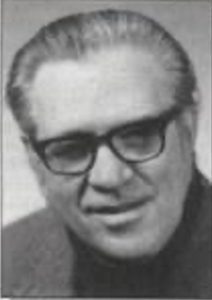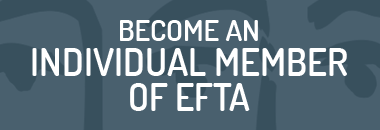EUROPEAN FAMILY THERAPY ASSOCIATION
CONNECTING FAMILY THERAPISTS AND TRAINERS
Carl Whitaker
(1912-1995) American psychiatrist, one of the pioneers of family therapy.

Umberta Telfener: I arrived in Wisconsin with the airplane from Philadelphia, the plane was late and I arrived at Whitaker’s mental health clinic out of breath. He was starting a session and his wife – the usual co-therapist – was sick at home. We shook hands and he immediately asked me to enter into the session with him. I knew he used to enter into a primary process mode and that he used to escalate with the client in a sort of delirium but I was not prepared for what happened in the session. There was a mother, a father and a 19 years old son who was diagnosed as psychotic. Carl and the boy started elaborating how to kill his parents: grounding them as hamburgers? Cutting them in pieces and throwing them as food to fishes? Giving them fire? I was confused and scared of the verbal escalation of the two; the parents were nodding in agreement and the young man at a certain moment stated, “Let’s not exaggerate”, while Carl was continuing. He seemed to have great fun: “Only one person can occupy the same craziness at the same time”, he used to teach and I was witnessing it first-hand. I followed the mandate I had received, I called him back from the hyper uranium where he seemed to be, pulling his jacket, and another appointment was scheduled. The session looked like chaos to me, I remembered a phrase from a book of his (“the therapeutic problem is to increase the complexity of the situation rather than restore order” and I tried to relax.
Τhe first time we were able to talk together after the session I have talked about, I introduced myself and he seemed curious and kind, very ironic. After about twenty minutes of the conversation he rose and went to his library picking up a book “On loneliness” and giving it to me as a present. I remember feeling recognized as never before, tears were in my eyes and I hugged him with no other words spoken on the subject ever. I still remember the book, thin, white cover, black writing: how did he find out?
Carl seemed very serene about death, he would take it seriously but with no anxiety, he seemed not frightened. More than once I heard him state that we were not responsible if a client tried to kill him/herself, even if I am not sure about this. Once – it was 1979 and I was in Wisconsin with him – he was invited to an evening “On death and dying”. I was present at the phone call: he thanked, proposed a joke about his intention to live much longer and said he would come to the evening – as we did – with his father, who was older, therefore more prepared than him and thus had more to say on the subject.
Theo Compernolle: During my journey In the USA at the end of the 1970, I had the opportunity to spend some time with Carl Whitaker. Alongside a couple of residents, from behind the one-way screen, I observed him in a session with a very affluent couple. To my surprise, at one point, Carl dozed off, emitting a slight snore. The couple remained silent, unsure of how to react. When he eventually woke up, the conversation resumed. During the debriefing, I mustered the courage to express my embarrassment over his momentary slumber. To my surprise, he responded with a grin, reassuring me that I needn’t feel ashamed. According to Carl, it was the couple’s responsibility to ensure that their expensive conversation with him was engaging enough to keep him from falling asleep.
Edith Goldbeter: Our Brussels institute had organized a 2-day workshop in Paris with Mony and Carl Whitaker, who had already been with us in Brussels a few times at our conferences and wanted to discover Paris.
The workshop started on Friday afternoon at around 3pm. In the morning, Mony and I took Carl Whitaker and his wife to the Musée Picasso. We passed through the pink and blue periods with shared pleasure. We saw Carl Whitaker decomposing in front of a cubist painting. He murmured : “He’s crazier than I am!”
From then on, Carl Whitaker looked totally lost, so the three of us framed him and took him out of the museum. We went for lunch (almost in silence) and took Carl Whitaker and his wife back to the hotel to give them a moment’s rest.
I remember that Mony and I, in the hotel lobby where we were having coffee while waiting, shared our concern for the afternoon, especially as the workshop was taking place at the École de Médecine, a place representing an intellectual summit for a man who, like Whitaker, prided himself on being an uncultured peasant (even though he was a psychiatrist and a university professor).
The four of us then took the cab to the Workshop venue, and after Mony’s introduction, Carl Whitaker began to speak. I recall with some emotion an extract of what he said: “I’ve been the schizophrenic in my family, but this morning I met someone crazier than me: Pablo Picasso!” and calmly recounted the scene we’d been confronted with that morning! I was stunned by this man’s ability to use his own experience to make it shareable and didactic!
Rossella Aurilio: In the early 1980s Carl Whitaker was considered an undisputed ‘Star’ in Italy, especially by young students of family therapy. We were the generation that had contributed to upholding various myths, but also the one that had courageously thrown itself into the forefront of the struggles to break down ideologies, prejudices and social stereotypes, in which we no longer wanted to be ensnared. It is, I believe, for this reason that we approached the Stars with an attitude of veiled suspicion.
Carl Whitaker had fascinated and convinced the young founding fathers of family therapy in Italy. In particular it was Maurizio Andolfi, at whose school I was training, who introduced him to the wider Italian public.
Like many, I was eager to meet him and attend one of his legendary clinical seminars, I remember that I had no doubts or any kind of ambivalence thinking about this event. When Maurizio announced Whitaker’s coming to Rome I signed up for the seminar immediately.
We were a real crowd, a hall packed with therapists of different ages and experiences, teachers and students in training like me. Where I was standing I could see and hear without difficulty. I cannot reconstruct exactly, even now that I relive that wonderful memory, what triggered the emotional wave that washed over me.
Was it his checked jacket, “too American” ? His irrefutable certainty that we are the product of distant family histories ? The provocative statement that individuals did not interest him? The methodological indication that families should only be received in full without excluding the dog and the goldfish? Perhaps it were all these elements that mingled with the many hours spent discussing in student collectives the emancipation from families of origin, the importance of the individual’s self-determination, the value of ties with those we shared ideas and goals with, what is certain is that a great fire invaded my head and heart and impudently pushed me to confront Whitaker in the middle of his seminar and in front of a crowd of over a thousand people.
“Prof Whitaker, what happens to the individual within your vision of care? Caged and enclosed within the family, crushed by the weight of the three-generational inheritance, where is the chance to self-determine, free him/herself from these conditioning and choose a path of freedom?” Whitaker looked at me with calm attention and his reply was delivered in a warm, participatory voice.
“I am very sorry that you have suffered so much, but you can’t help but consider that families are not all the same as the one you lived in, you have to be able to believe that there are completely different families full of resources and enormous possibilities for those who are part of them”.
This is how I came to know him, as he created an intimate and profound dimension in the midst of so many people, and this is how I came to know the possibility of crossing an idea, a belief, a theory to go beyond it, right to touch a pain in the heart.
Maurizio Andolfi: I visited Carl many time when he was at the Department of Psychiatry in Madison ,Wisconsin. He was a very strange prof. for many residents who were resistant to be supervised by him. He was dealing with them in the same way he would approach families in treatment. No professional mask, no psychiatric jargon.. no difference . “People are people”.
I was very curious about his professional diary. In any page of it, he marked his hourly appointment with a cross. At 9 am there was an x, at 10 am the same x etc. I was surprised by this way to keep note of his appointments and I asked “ Carl, how do you know why is coming at 9 am or at 10am?”. He answered “ When they knock at the door and they come in , I will know who they are”. A very personal way to keep distance.
Camillo Loriedo: Rather than a structured form of training, Carl Whitaker introduced a real revolution in the field of psychotherapy: rather than teaching how to do psychotherapy, one could say that his main endowment was to teach how to become a psychotherapist.
Here, however, taking up Umberta’s invitation, I would like to recall how he taught, especially the less formal and quieter part of his teaching methods, a part that came to me not so much through his writings or through lectures and seminars as is usually expected of a teacher. Completely consistent with his experiential approach, I always had the feeling that Carl communicated most effectively not through well-argued theory or convincing explanations, but through seemingly simple phrases that were part of a normal conversation and seemed to be thrown in by chance, and even more so through a series of episodes, also seemingly accidental, that arose spontaneously in the free spaces between seminars.
I have the distinct feeling that I learnt much more from him during informal conversations that originated on the way back from the airport or over a plate of ‘pasta with aubergines’ (one of his favorite Italian dishes) than through formal teaching.
The first impact of these unexpected out-of-context learning experiences had as an immediate side effect a sort of confusion that lasted a few hours after a ‘casual’ conversation or after sharing some ‘trivial’ activity of daily life. In that ‘after’, I would sometimes remain so deeply absorbed in my thoughts that I could not remember where I had parked my car, or how to find my way home. Usually I would realize that I had acquired unusual behavior for me, but then I would need weeks or months to mature and feel that I had understood something new.
I consider these stories about him an indirect but substantial contribution to my symbolic-experiential training with Carl.
One of Whitaker’s basic principles was his belief in the concept of We-ness. His idea was to trust not individuals, but their relationships, in other words, We-ness. Thinking of relationships as more trustworthy than individuals immediately seemed to me a wise principle, a coherent and intelligent expression of systems thinking. Purely intellectual learning, however, made me perceive this idea as stimulating, but at the same time as cold and distant as a mountain of snow to a deep-sea fisherman. It was only a few years later that experiential learning managed to correct the intellectual perception.
I was visiting Carl at his home in Madison, Wisconsin. Early one morning, he asked me to accompany him for a canoe ride. For him it was a daily habit. To me, however, the canoe seemed a rather uncomfortable and awkward way to explore Lake Mendota, but despite appearing to my eyes much narrower and more unstable than any boat I had been in before, I decided to trust Carl and, after some initial uncertainty, I felt safe and comfortable. We spent a very pleasant afternoon together enjoying the beauty of the lake and discussing life.
A few days later, Carl had a meeting that I could not attend, so I had a morning free. Before leaving me alone at his place, he suggested that I use whatever I wanted. Still with the good experience of the day before in mind, the first idea was to go for a nice canoe ride again.
I felt confident, and I remember jumping into the boat with agility and ease. After a minute of canoeing I found myself, fully clothed, in the cold waters of Lake Mendota. Without Carl’s presence and without his ability to compensate for all my movements, my balance disappeared and the canoe suddenly went upside down. Thus I realized to my cost the experiential difference between an individual (wet) and a relationship (safe and dry).
The therapist’s access to his own emotions is another of Whitaker’s key principles. When I first met Carl I was 28 years old, and I was rather shy and tended to be controlled in the expression of my emotions. Probably because of these personal characteristics, despite all my efforts, I could not put this basic concept into practice. Understanding it rationally was one thing, but applying it when needed was something else. In these cases both theoretical teaching and books fail to be much help and, for his part, Carl had always been kind enough to me never to mention the presence of this problem. In fact, contrary to what many therapists tend to do, I never saw him tell anyone what he should change or improve in. He expected change, but never demanded it.
This time, both Prof. Vella and I were in Madison for one of our study visits. After several very busy days, in which we had followed his intense work schedule, watched him from behind the mirror, or had co-therapy with him, one day unexpectedly Carl said smiling to Prof. Vella and me: “We are not going to work today!“
Heedless of our surprise, he left us no time to ask questions and immediately said: ‘Let’s go‘, without explaining where, but we, as always, followed him, knowing that he was certainly preparing tasty ingredients for the day’s food.
Only once we arrived did we realize that the destination was a small local airport, a few miles from the city of Madison. Even more surprising was the fact that there was a very small plane waiting for us. Before I could comprehend Carl gently pushed me inside the plane in the back seat, and Vella was placed in the front next to the pilot. Clearly I was in no condition to escape in any way, and only after Carl closed the door did I learn that the man driving the plane was Carl’s son-in-law who happened to be an acrobatic pilot. He was very happy to show us, in his own way, through daring evolutions and sudden dives around Madison, and Vella, who had been an air force officer in the army, greatly appreciated these reckless evolutions. On the contrary, I was literally terrified, and politely asked for the flight to be more touristy, without too many aerobatic figures, but both Vella and the pilot were so caught up in the excitement that they did not even hear my faint voice.
After 10 minutes of incredible maneuvers in the skies over Madison, I found myself completely losing my rigid self-control, and fear finally drove me to find the courage to scream, as I had never been able to do before.
At the time it didn’t seem to me that much had changed, maybe I just felt a little more agile in my therapeutic relationships. But when on a later occasion I found myself together with Carl in a terribly boring session with the family of a depressed patient, I suddenly realized that I could not bear the idea of repeating the usual rational (and boring) interventions from my repertoire. To my own surprise, I found myself making what I later considered to be a sort of liberating, though totally senseless move: I pulled a luminescent yo-yo out of my pocket (a present I had bought that very day for my son, then a child), and started to play with it. Carl looked at me a little surprised, but then asked me to swap the yo-yo with him, and shortly afterwards the whole family started to participate in the game by passing the yo-yo around and abandoning their usual rigidity. At this point, even the depressed patient raised a hand to indicate that he also wanted to have his turn at the game and, having taken the yo-yo, incredibly demonstrated that he was the best at it. It was a test of skill that interrupted a long period of depressive incapacity and was greeted by the whole family with a hearty laugh.
At the end of the session I expected Carl to make some comment about the family or the patient. Instead, he looked at me smiling and said: “I feel like you finally found the courage to be crazy today.”
Another time, we had to decide which type of family was most appropriate for a live session at his next workshop in Rome. I had started by suggesting to Carl that we interview psychotic or borderline families: I was interested to see how he coped with particularly complicated cases. He thought very briefly about my suggestion, then smiled and said: ‘The most difficult of all is definitely the normal family. Why not have a session with a normal family?” My spontaneous reaction was: “That’s a crazy idea“. But in the end, together with my colleagues at the Relational Psychotherapy Institute in Rome, we started looking for a normal family.
Of course, we had great difficulty finding one, but we finally managed to find a family that had no symptoms or problems at the time. Carl accepted this solution, but soon afterwards he told me that I should also participate in the interview with him. At the time, this did not seem like a big deal to me and I accepted without realizing the consequences. I went into the session smiling, but after five minutes I started to feel anxiety and discomfort: no one had ever taught me this and the situation forced me to realize from direct experience that I did not know how to interview a normal family at all.
In my previous training I had received a set of instructions on how to interview problematic families and how to conduct different types of interviews for different family problems, but what to do when the problem was not there? I was completely lacking the knowledge to interview ‘the most difficult family’, the normal family. Watching Carl I realized that instead he was relaxed and amused as he interviewed the family with interest and participation.
Another experiential learning in which I realized for the first time that I was only able to see the dysfunctional patterns in families, while I was completely in the dark about their functional side.
The experience of that darkness, more than any theory, taught me to look for resources and potential not only in normal families, but also in the most dysfunctional human systems and, since then, has made me feel compelled to look for the normal family in every problematic family I would encounter in the future.
These episodes represent for me, along with many others, an experiential learning of symbolic therapy that has changed my view of therapy over time. Whether I have improved as a result of all these experiences I cannot say. I can only say that they made me very emotional.
Giovanni Madonna: Do you think that juxtaposing Carl Whitaker’s clinic with the Ecology of Mind, i.e. with the epistemological matrix proposed by Gregory Bateson, is improper or risky? In my first book, published in 2003 and subsequently reissued in 2013, I argued the opposite. I proposed a theory of psychotherapeutic action in which, in keeping with the Batesonian approach to the general lines of a theory of action, psychotherapeutic intervention could be considered possible, but necessarily cautious, not hasty and not arrogant. The image that came to my mind when thinking of such an intervention was the Whitakerian image of ‘the growing edge’: for Carl Whitaker, in fact, psychotherapy consisted in intervening on a wound by simply cleansing its tissues so that its edges could better and more rapidly generate new cells capable of moving towards each other to reach each other and allow healing. The action in psychotherapy would therefore have to be non-invasive and respectful of the organisms’ capacity for self-regulation and self-repair, a capacity that all creatures have in common with the Creature, i.e. with the whole world of mental processes that Bateson defined as “a tautology capable of slowly healing itself” (1979, p. 272).
Umberta Telfener: Carl Whitaker, a founder of family therapy, warned the public, many times: I have a theory that theories are destructive … all theories are bad except for the beginner’s game playing, until he [or she] gets the courage to give up theories and just live. Theory destroys creativity and intuition and eventually destroys the therapist.



